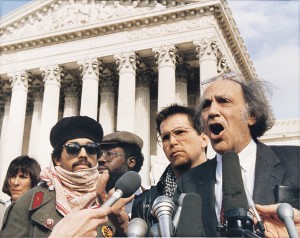
ACU alum David Leeson photographs several protesters during the 1984 Republican National Convention
Facts: During the Republican National Convention in Dallas, Texas, in 1984, Gregory Lee Johnson, a member of a group of protesters, burned an American flag in front of Dallas City Hall. Johnson was charged with “the desecration of a venerated object,” which violated a state law.
The Law: A Texas law stated that a person may not “intentionally or knowingly desecrate” a national flag, among other things. Supreme Court case West Virginia Board of Education v. Barnette stated that the State cannot “carve out a symbol of unity and prescribe a set of approved messages to be associated with that symbol.”

Greg Johnson, middle, his attorney, right, and an odd man in a beret, left, appear on the steps of the Supreme Court building after oral arguments in Texas v. Johnson in 1988.
Litigation History: Johnson was convicted, and a State Court of Appeals affirmed the conviction. The Texas Court of Criminal Appeals reversed the decision because Johnson’s actions were protected under the First Amendment.
Legal Question: Does the Constitution’s free speech clause prohibit states from punishing the desecration of the American flag as a form of protest?
Outcome: Affirmed, 5-4. Justice Brennan wrote the opinion and Marshall, Blackmun, Scalia and Kennedy agreed. Kennedy also filed a concurring opinion. Justice Rehnquist dissented and White and O’Connor agreed. Justice Stevens also filed a dissenting opinion.
Rationale/Rule/Analysis: The political nature of Johnson’s actions was “both intentional and overwhelmingly apparent.” Brennan disagreed with the state’s argument because, “no actual breach of the peace occurred at the time of the flagburning or in response to the flagburning.” In addition, the State’s interest in preserving the flag as a symbol of nationhood and national unity was not sufficient to support Johnson’s conviction.
Concurrence (Kennedy): The outcome of this case is distasteful, but “the fact remains that his acts were speech, in both the technical and the fundamental meaning of the Constitution.”
Dissent (Rehnquist): The flag is a strong national symbol stating, “No other American symbol has been as universally honored as the flag.” He recalled the unity it brought to the 13 colonies during the Revolutionary War and gave Americans in subsequent wars. He also mentioned the affect flag burning had on morale during the Vietnam War.
Dissent (Stevens): “(S)anctioning the public desecration of the flag will tarnish its value.”
Kenneth R. Pybus
Other Resources
Television news coverage of the event:
[youtube HNVUZmNhX3Q]Johnson appeared on the ABC News show Nightline in 1988 after the decision was announced.
[youtube RwfhVRt-kv0]Part 1
[youtube bh95N1isqj4]Part 2
